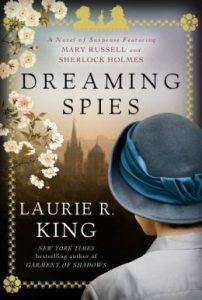Review: In “Dreaming Spies,” Mary Russell Unfortunately Forges the Way
Emily Mackenzie // Blog Writer

Dreaming Spies by Laurie R. King
Random House | February 17, 2015
352 pages
Barnes & Noble | Random House
When I first picked up Dreaming Spies, the concept was intriguing. The premise of the mystery series is focused on an imagined character, Mary Russell, a well-educated twenty-four year old with a strong aptitude for noticing when some things just don’t add up, who marries Sherlock Holmes. In the first novel, Mary, only fifteen, and Holmes meet by chance, which begins the development of their relationship from teacher and pupil, to master and apprentice, to husband and wife in the following novels. The series is constructed from the masterpiece detective series of Sir Conan Doyle, as if Holmes was in fact a real man that Doyle chose to base a series of stories upon. I’m not usually a mystery reader, but I do enjoy historical fiction, this particular novel is set between 1924 and 1925, and was still attracted to the unique spin of the series. However, I was ultimately disappointed with this novel.
As this is the thirteenth installment of King’s Mary Russell and Sherlock Holmes mystery series, if you have already journeyed with this crime-solving duo for the past twenty-one years, then you will likely find Dreaming Spies to fall in line after the others. In this adventure, Mary Russell and her much older husband Sherlock Holmes embark on a journey to Japan from their home in Oxford, England. While onboard the Thomas Carlyle, Holmes becomes interested in the wealthy Lord Darley, a known blackmailer, and his family, while Russell befriends a young Japanese girl. From there, a mystery of forgery, blackmail, and subterfuge evolves. The case becomes a matter of international diplomacy that could lead to the dishonor of the Japanese Prince Regent, and Russell must figure out if it is mere coincidence that she and Holmes happened upon the case or if they were pawns in a much larger but well-executed scheme of secrecy and manipulation.
Having not previously read the earlier books in the series, it wasn’t difficult to piece together backstory for Mary and Holmes’unique relationship as they carried this particular story along. Mary, as narrator, provides a light and frivolous read for a weekend of boredom. However, a mystery about an ancient book forgery came across as uninspired, and the pacing, weighed down by summary-heavy, textbook descriptions of Japan, made the novel drag on one-hundred pages longer than it could have.
Separated into three sections, the mystery comes to a reasonable conclusion at the end of “Book Two,”yet unsuccessfully attempts to amp the drama and surprise the reader with a cheap twist. In “Book Three,”the ancient book that seems to have been returned to its rightful owner, the Prince Regent, turns out to be a second forgery in an anticlimactic attempt to undermine the earlier false ending. Each time King builds tension and the reader’s expectations, she directly short-circuits the suspense with a broad statement as to why the situation was resolved uneventfully. The most exciting situations in the novel are cliché. Two examples are when Mary Russell encounters a bear and when an unsteady waiter loses his balance, causing the whole plan to retrieve the Prince’s book to fall apart. They are also far too quickly brushed over in summary to have a memorable impact on the novel.
If I had already grown attached to Mary Russell and Holmes, I might find Dreaming Spies charming and uncomplicated, however as a first time reader, I’d have much rather skipped this particular novel for a more complex crime drama.

I just read this book, the first of the Russell series that I have read. As were you, I was initially excited to read this book. but I share your responses. The book was too long by a third–and the multiple endings frustrated me (and bored me). While I enjoyed some of the story of trekking in Japan, that story was not enough to lure me to read other books in this series.